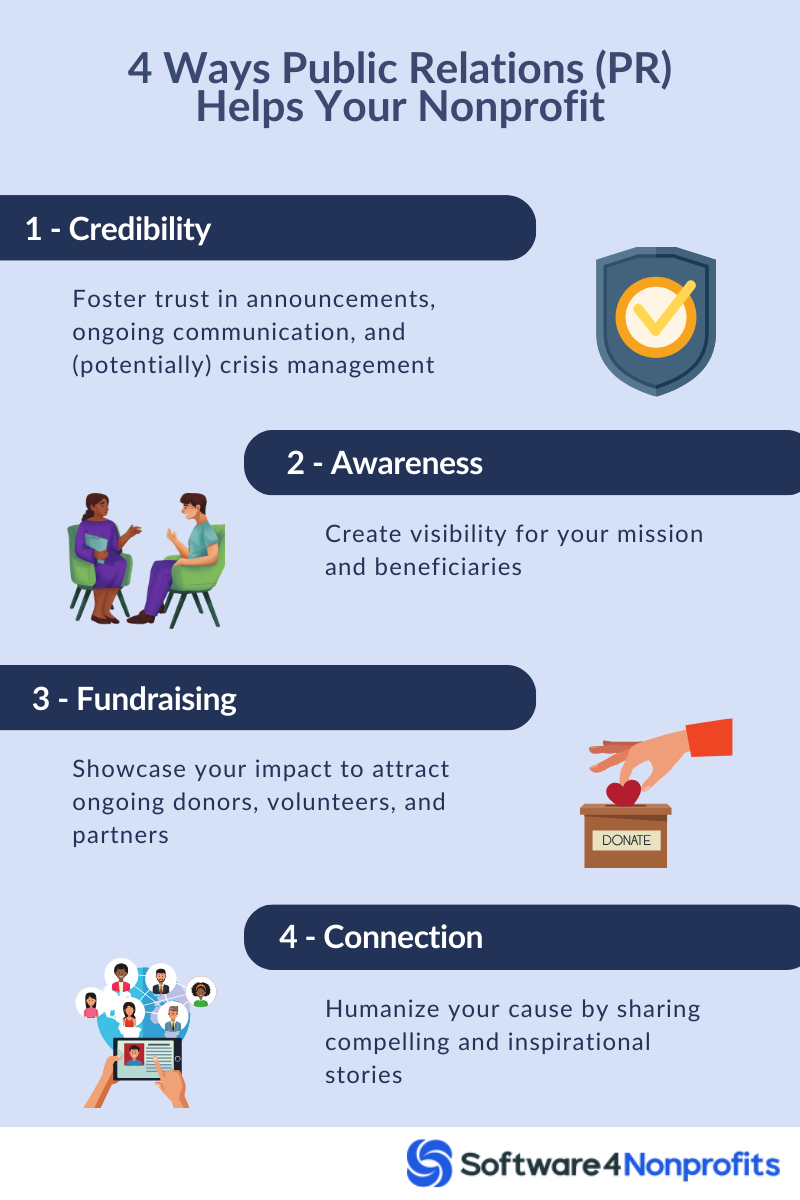In the realm of nonprofit public relations, effective communication stands at the forefront of success. Dive in to discover best practices and deepen your nonprofit’s connection with its audience.
Importance of PR in the Nonprofit Sector
Public Relations (PR) is a pivotal tool for nonprofit organizations. It not only promotes its missions and vision but also builds a bridge between the organization and its stakeholders. The value of PR in the nonprofit sector can be dissected into several critical components:
1. Building Trust and Credibility
- Trust Foundations: For charities, trust goes beyond just a good reputation; it’s their core value. Effective PR promotes clear communication, solidifying this bond of trust with stakeholders.
- Crises Management: When facing PR setbacks, whether from financial hiccups or unexpected events, a nonprofit’s response is vital. The right PR approach can help them tackle these issues while upholding or restoring their trusted status.
- Consistent Messaging: Consistency in communication reaffirms the organization’s commitment to its mission, thereby bolstering credibility. Regular updates, annual reports, and transparent financial disclosures are vital components of this.
2. Increasing Visibility and Awareness of the Cause
- Reaching a Wider Audience: Through media engagements, press releases, social media campaigns, and community outreach, PR helps the nonprofit reach audiences far beyond its immediate circle.
- Educating the Public: Many nonprofits operate in niche sectors or address lesser-known issues. PR allows these organizations to educate the public about the significance of their cause, driving greater awareness and understanding.
- Positioning as a Thought Leader: Regular publications, op-eds, and participation in public forums can position the nonprofit as a thought leader in its domain, further amplifying its voice and reach.
3. Attracting Donors, Volunteers, and Partnerships
- Showcasing Impact: Potential donors and partners want to know how their contributions will be used. Through effective PR, nonprofits can showcase the tangible impact of donations, convincing potential donors of the worthiness of their cause.
- Engagement Strategies: Through tailored PR campaigns, nonprofits can engage potential volunteers, highlighting the personal growth opportunities and societal impact of volunteering.
- Collaborative Opportunities: Strategic PR can help highlight partnership success stories, encouraging other entities, be it corporates or governmental bodies, to collaborate, ensuring mutual growth and amplified impact.
4. Sharing Success Stories and Impact Narratives
- Humanizing the Cause: Personal stories can resonate deeply, creating an emotional connection with the audience. By sharing beneficiary testimonials or volunteer experiences, organizations can humanize their cause, making it relatable and compelling.
- Demonstrating Accountability: Sharing impact narratives is also a way of demonstrating accountability to stakeholders. It’s a way of saying, “Here’s the change your support has created.”
- Inspiring Action: Real-life success stories can inspire others to take action, be it in the form of donations, volunteering, or simply spreading the word. They serve as proof of the nonprofit’s efficacy and the difference that individual and collective actions can make.

Unique Challenges and Opportunities of PR
Nonprofits have unique PR challenges and opportunities because of their mission focus and stakeholder reliance. Grasping these details can lead to better strategies and stronger stakeholder connections.
Challenges
- Resource Limitations: Many nonprofits operate on tight budgets, limiting their ability to invest in extensive PR campaigns, hire specialized staff, or utilize premium tools and platforms.
- Diverse Stakeholder Expectations: Nonprofits need to communicate with a wide range of stakeholders: donors, volunteers, beneficiaries, policymakers, and the general public. Addressing the varied expectations and interests of each group can be complex.
- Increasing Competition: The nonprofit sector has witnessed a surge in the number of organizations, leading to competition for attention, donors, grants, and other resources. Standing out and differentiating oneself can be challenging.
- Crisis Management: Nonprofits are under constant scrutiny. Any mismanagement, perceived lack of transparency, or deviation from the mission can lead to a PR crisis, potentially damaging reputation and donor trust.
- Narrative Sensitivities: These organizations often deal with sensitive issues. Crafting narratives that are impactful without being exploitative or causing harm can be a fine line to tread.
- Measurement Difficulties: Quantifying PR success in the nonprofit sector can be challenging. While for-profit businesses can look at sales or revenue, nonprofits must gauge less tangible results like awareness, behavioral change, or stakeholder trust.
Opportunities
- Authentic Storytelling: Nonprofits are inherently involved in transformative work that impacts real lives. This gives them a treasure trove of authentic stories that can resonate deeply with audiences, fostering emotional connections.
- Community Mobilization: Organizations have often devoted communities of supporters. Leveraging these communities can create grassroots PR campaigns, where passionate individuals become ambassadors for the cause.
- Collaborative Partnerships: Nonprofits have the opportunity to collaborate with businesses, other NGOs, or governmental bodies. These collaborations can amplify reach and lend additional credibility.
- Digital Outreach: With the rise of social media and digital platforms, organizations can engage with a global audience at relatively low costs. Platforms like Facebook, Twitter, and Instagram allow for direct communication and engagement with supporters.
- Pro Bono Support and Volunteer Expertise: Many professionals offer their expertise to nonprofits on a pro bono basis. This can include PR professionals, graphic designers, or digital marketers, providing access to top-tier skills without the associated costs.
- Trust in the Nonprofit Sector: Generally, the public holds a favorable view of nonprofits, perceiving them as working for societal good. This inherent trust can be a solid foundation upon which to build PR strategies.
- CSR Initiatives: Many corporations have corporate social responsibility (CSR) initiatives and are looking to partner with nonprofits. This can lead to joint PR campaigns, where the nonprofit benefits from the corporation’s resources and reach.
Understanding Your Target Audience
Understanding the target audience is crucial for any organization, but for nonprofits, it becomes even more vital. These organizations often rely on a delicate balance of stakeholder engagement to succeed in their missions. Tailoring messages and approaches to resonate with various audience segments can significantly amplify the impact of their outreach efforts.
1. Identifying and Segmenting Stakeholders
Every nonprofit interacts with a diverse set of stakeholders, each with its own interests, motivations, and expectations. These can range from beneficiaries, volunteers, and donors to policymakers, partners, and the general public. Identifying these groups is the first step.
Once identified, segmenting or categorizing them allows the nonprofit to tailor its communication strategies. For instance, while beneficiaries might be more interested in the direct services the nonprofit offers, donors might be keen on understanding the financial utilization and impact metrics. By segmenting stakeholders, nonprofits can ensure that each group receives relevant information in a manner that resonates with them.
2. Demographic and Psychographic Profiling
Once stakeholders are segmented, a deeper understanding can be gleaned through demographic and psychographic profiling. Demographic information—such as age, gender, location, education, and income level—offers insights into the general characteristics of the audience.
On the other hand, psychographic profiling delves into more intangible aspects, capturing information on attitudes, values, interests, and lifestyles. For a nonprofit, this could mean understanding why certain donors are motivated to give, what drives a volunteer’s passion, or what challenges a beneficiary faces.
When combined, demographic and psychographic insights allow for a comprehensive understanding of stakeholders, enabling nonprofits to craft messages that are not only relevant but also deeply impactful.
3. Surveys and Feedback to Understand Stakeholder Needs
Active engagement through surveys and feedback mechanisms is a proactive approach to understanding stakeholder needs and perceptions. Regularly soliciting feedback, be it through formal surveys, focus group discussions, or informal chats, can provide a wealth of information. For instance, donors might feel that they want more regular updates on how their contributions are utilized.
Volunteers might have suggestions for improving on-ground operations. Beneficiaries might provide insights into gaps in service delivery. By actively seeking and then acting upon this feedback, organizations can ensure that they remain aligned with stakeholder needs, continually refining their approaches for maximum impact.
Moreover, the very act of seeking feedback can in itself be a powerful tool for stakeholder engagement, as it signals that the organization values and respects its opinions.
Monitoring and Evaluating PR Efforts
Effective public relations (PR) doesn’t end once a message is out in the world. To ensure the true impact of any PR campaign or effort, nonprofits need a robust system for monitoring and evaluation. This not only provides insights into the campaign’s success but also offers valuable lessons for future initiatives.
1. Setting Measurable PR Goals
- Defining Success: Before launching any PR effort, it’s crucial to define what success looks like. Is it an increase in donations, heightened awareness about an initiative, or more volunteers signing up? Having a clear objective in mind helps tailor the PR strategies and provides a benchmark against which outcomes can be measured.
- SMART Goals: PR goals should be Specific, Measurable, Achievable, Relevant, and Time-bound (SMART). Instead of a vague goal like “increase website visitors,” a SMART goal would be “achieve a 20% rise in website traffic over the next three months.”
- Diverse Metrics: PR encompasses various facets, from media mentions and audience engagement to stakeholder perceptions and behavioral changes. Hence, it’s essential to set multiple metrics aligned with the diverse objectives of the PR effort.
2. Utilizing Analytics and Tracking Tools
- Digital Analytics: For online PR campaigns, tools like Google Analytics, social media insights, or email campaign trackers can provide a wealth of data. These can track metrics like engagement rates, click-through rates, audience demographics, and more.
- Media Monitoring Services: Services like Meltwater or Cision help nonprofits track mentions across various media outlets, be it print, broadcast, or online. Such tools offer insights into the reach and tone of media coverage.
- Engagement Trackers: For events or direct engagement initiatives, tools that monitor attendance, participation rates, or feedback can be invaluable. These might range from event sign-up software to post-event survey tools.
3. Gathering Feedback and Making Necessary Adjustments
- Direct Stakeholder Feedback: One of the most authentic sources of insights is direct feedback from stakeholders. Whether it’s through surveys, focus groups, or informal interactions, understanding their perceptions, needs, and feedback can provide a clear picture of the PR effort’s effectiveness.
- Iterative Adjustments: PR is not a one-size-fits-all endeavor. Based on the feedback and analytics, nonprofits might need to make adjustments. Maybe a particular message isn’t resonating, or perhaps a chosen channel isn’t yielding results. Being flexible and open to course correction ensures the PR efforts remain effective and relevant.
- Post-Campaign Reflection: Once a PR initiative concludes, it’s beneficial to have a reflection phase. This involves gathering all stakeholders, reviewing the set goals versus the achieved results, understanding what worked and what didn’t, and documenting lessons learned for future campaigns.
The real power of PR lies not just in disseminating messages but in understanding their impact. For nonprofits, where resources are often tight, ensuring that every effort counts is paramount. A rigorous system for monitoring and evaluating PR initiatives ensures that the organization’s messages are not just heard but also lead to desired actions and outcomes.
Crafting a Compelling Message
In a world inundated with information, it’s no longer enough for nonprofits to merely communicate; they must do so compellingly. Crafting a message that resonates can mean the difference between being heard and being overlooked. For mission-driven organizations, this resonance can drive support, mobilize resources, and amplify impact.
Developing a Consistent and Authentic Brand Voice
A brand voice is more than just the words used; it’s the tone, style, and essence of every communication piece. For nonprofits, this voice must reflect their mission, values, and ethos. Consistency in this voice across all channels—be it newsletters, social media, or press releases—fosters recognition and trust among stakeholders.
However, consistency shouldn’t come at the expense of authenticity. In the nonprofit world, authenticity translates to transparent and genuine communication. It means avoiding jargon or overly polished narratives and instead, speaking from the heart about successes, challenges, and aspirations.
An authentic voice isn’t afraid to admit mistakes but also shares lessons learned and steps taken for improvement. This blend of consistency and authenticity strengthens the bond between nonprofits and their stakeholders, creating a foundation of trust and mutual respect.
Telling Impactful Stories – Humanizing Your Cause
Data and statistics have their place, but stories give life to numbers. Impactful storytelling is about humanizing the cause. Instead of merely stating that a nonprofit helped 1,000 children access education, narrating the journey of one child, their dreams, hurdles, and achievements, brings the mission closer to the audience’s heart.
Humanizing stories often focus on individuals or communities, showcasing their resilience, aspirations, and transformations. These narratives offer stakeholders a window into the ground realities, making abstract concepts like ‘poverty alleviation’ or ‘environmental conservation’ tangible and relatable. By fostering emotional connections, these stories inspire empathy, understanding, and action.
Utilizing Testimonials and Case Studies
Testimonials and case studies serve as powerful tools in the nonprofit messaging arsenal. They offer third-party endorsements, enhancing the organization’s credibility and showcasing its impact.
- Testimonials: Direct quotes or narratives from beneficiaries, volunteers, or partners act as authentic endorsements of the nonprofit’s work. When a beneficiary shares their transformative journey or a volunteer talks about their enriching experience, it provides a firsthand account of the organization’s impact, making the message more believable and relatable.
- Case Studies: Going beyond testimonials, case studies offer a detailed exploration of specific projects, interventions, or initiatives. They combine narrative storytelling with data, showcasing challenges faced, solutions implemented, and results achieved. By highlighting the strategies and methodologies adopted, case studies serve as both testimonies of impact and repositories of knowledge.
In sum, crafting a compelling message is both an art and a science. It’s about blending authenticity with strategy, emotion with data, and inspiration with information. For nonprofits, mastering this craft can be a game-changer, transforming passive listeners into passionate advocates.
Effective Communication Channels for Nonprofits
In today’s rapidly evolving communication landscape, nonprofits need to strategically leverage a mix of traditional and modern channels to maximize their outreach and impact. Each channel has its strengths, suited to different goals, audiences, and messages.
Traditional Media
- Press Releases: These are official statements issued to newspapers giving information on a particular matter. For nonprofits, press releases are valuable for announcing significant milestones, events, partnerships, or campaigns. When well-crafted and distributed, they can secure coverage in local or national news outlets, enhancing visibility and credibility.
- Op-eds: Opinion pieces, or op-eds, allow nonprofits to delve deeper into issues, advocating for change or highlighting insights. They provide a platform to position the organization as a thought leader, sparking discourse on critical topics.
- Community Radio: In many regions, especially rural or under-resourced areas, community radio remains a primary information source. It offers a grassroots medium to engage directly with beneficiaries, share stories, and raise awareness about initiatives. It’s especially potent for nonprofits working on community-centric projects.
Digital Platforms
-
- Websites: A nonprofit’s website is its digital front door. It offers comprehensive information on the organization’s mission, projects, impact, and ways to engage. A well-designed, user-friendly website enhances credibility and provides a platform for various digital initiatives.
- Blogs: Blogging allows nonprofits to delve into topics in detail. Whether it’s success stories, project insights, or industry trends, blogs provide a medium to communicate in a more informal, engaging manner. They also boost website SEO, attracting more organic visitors.
- E-newsletters: Regular newsletters keep stakeholders updated on recent developments, events, and opportunities to engage. Personalized and segmented e-newsletters can nurture relationships with donors, volunteers, and partners, fostering sustained engagement.
Social Media
- Facebook: With its vast user base, Facebook is ideal for reaching diverse audiences. From sharing stories and updates to hosting fundraisers, it offers multiple tools tailored for nonprofit engagement.
- Twitter (Now X): This platform is excellent for real-time updates, advocacy campaigns, and engaging with influencers or policymakers. Its hashtag-driven ecosystem can amplify campaign reach and foster community engagement.
- Instagram: Being a visual platform, Instagram is perfect for sharing impactful photos and short videos of on-ground work, beneficiaries, and events.
- LinkedIn: For nonprofits seeking partnerships, volunteers, or even donors from the corporate sector, LinkedIn is invaluable. It’s also a platform to share more professional updates, articles, and industry insights.
- Emerging Platforms: Platforms like TikTok or newer entrants can be used to engage younger demographics, offering creative ways to share messages and foster engagement.
In-person Events and Community Outreach Programs
- In-person Events: Workshops, fundraisers, seminars, or community gatherings offer direct engagement opportunities. They foster a sense of community, provide platforms for direct feedback, and can be instrumental in donor cultivation.
- Community Outreach Programs: These programs take the organization directly to the beneficiaries or communities they serve. Whether it’s awareness drives, health camps, or educational workshops, outreach programs create tangible impact and offer rich stories for further communication.
Leveraging Partnerships and Collaborations
In the increasingly interconnected world, the adage “two heads are better than one” holds significant truth. For nonprofits, partnerships and collaborations can amplify their reach, resources, and resonance. These synergies, when well-leveraged, can create ripple effects that far outstrip what an individual organization might achieve.
Collaborative Events and Joint PR Campaigns
- Shared Objectives: Collaborative events and joint PR campaigns allow multiple entities to pool their resources towards a shared objective. Whether it’s a joint fundraising gala, a collaborative awareness marathon, or a shared online campaign, these initiatives combine the strengths of all partners involved.
- Wider Audience Reach: Each collaborating entity brings its audience to the table. As such, joint efforts ensure that messages reach a much larger and more diverse group than any single organization’s typical outreach.
- Resource Efficiency: Shared events or campaigns often mean shared costs and resources. This efficiency is particularly beneficial for smaller organizations, allowing them to be part of larger initiatives without bearing the entire burden of organization and cost.
Gaining Visibility Through Affiliations and Sponsorships
- Credibility Through Affiliation: Being affiliated with a well-respected partner or securing a reputable sponsor can significantly enhance a nonprofit’s credibility. Such affiliations signal to stakeholders that the nonprofit’s mission and work are recognized and supported by established entities.
- Enhanced Resources: Sponsorships often go beyond financial support. Sponsors might offer platforms, resources, expertise, or networks that can aid in the nonprofit’s initiatives. For instance, a tech company sponsoring a nonprofit could also offer technological support or solutions.
- Spotlight Moments: Partnerships with high-profile entities or events can place the organization in the spotlight, giving them platforms they might not usually access. Whether it’s a slot at a major conference, visibility at a large-scale event, or mention in a widely circulated publication, these moments can be invaluable for awareness and reputation-building.
Establishing PR Ambassadors
- Leveraging Influence: PR ambassadors, be they celebrities, industry leaders, or influencers, carry a weight of influence. When they speak on behalf of a nonprofit, their audience listens, leading to increased visibility and credibility for the organization.
- Consistent Advocacy: PR ambassadors act as consistent advocates for the nonprofit’s cause. Their sustained engagement can keep the mission in the public eye, driving continuous awareness and support.
- Human Connection: Ambassadors often share personal stories or reasons for their association with a cause. This human angle can make the nonprofit’s mission more relatable, bridging the gap between the organization and potential supporters.
In essence, partnerships and collaborations are force multipliers for nonprofits. They unlock doors to resources, audiences, and platforms that might otherwise remain inaccessible. However, for such synergies to succeed, it’s crucial that there’s a shared vision, mutual respect, and clear communication between collaborating entities. When these elements come together, the combined impact can be transformative, paving the way for sustained change and growth.
Ethical Considerations in Nonprofit PR
Public relations (PR) plays a pivotal role in shaping an organization’s public image and fostering trust with its stakeholders. For nonprofits, the stakes are even higher, as their credibility directly impacts their mission and the communities they serve. As such, embracing ethical considerations in their PR strategies is not just advisable but imperative.
1. Maintaining Transparency and Honesty
Maintaining transparency and honesty is fundamental to establishing and preserving trust in the nonprofit sector. Organizations should consistently offer clear, candid insights into their operations, finances, and outcomes. As we delve deeper, we’ll explore three critical aspects of this commitment:
Full Disclosure
Nonprofits should commit to full disclosure in their PR efforts. This entails being open about their sources of funding, operations, successes, and even failures. Stakeholders appreciate knowing where their funds are going, the challenges faced, and the impact achieved.
Managing Mistakes
Mistakes or oversights can happen in any organization. When they do, nonprofits should own up to them, communicate them honestly to their stakeholders, and outline the steps being taken to rectify the situation. This approach not only manages potential reputational damage but also reinforces the organization’s commitment to transparency.
Clear Communication
Ensuring that messages are clear, devoid of jargon, and are not misleading is crucial. This means avoiding exaggerated claims or overly optimistic projections, which can erode trust in the long run.
2. Ensuring Representation and Inclusivity
Ensuring representation and inclusivity is vital for organizations to genuinely resonate with diverse communities. By valuing varied perspectives, organizations amplify their impact and authenticity. In the following sections, we’ll delve into Diverse Voices, Cultural Sensitivity, and Accessibility.
Diverse Voices
PR efforts should reflect the diversity of the communities nonprofits serve. This means involving a spectrum of voices in communications, from the beneficiaries and volunteers to staff and donors.
Cultural Sensitivity
Nonprofits working across different cultures or geographies must ensure that their PR materials respect and are attuned to local customs, values, and norms. This avoids inadvertent misrepresentations or potential offenses.
Accessibility
PR materials should be accessible to everyone, considering factors like language, disability, and technological barriers. Whether it’s offering translated versions, ensuring website accessibility, or providing alternative formats, inclusivity should be at the forefront.
3. Avoiding Tokenism and Exploitative Narratives
Avoiding tokenism and exploitative narratives is essential for nonprofits to maintain genuine connections with their audiences. Mindful representation ensures the dignity and authenticity of all narratives. The following sections will delve deeper into the nuances of these ethical considerations.
Beyond Surface Representation
Tokenism involves symbolic, superficial efforts to appear inclusive without substantive change or representation. In PR, this might manifest as including diverse faces in promotional materials without meaningful engagement. Such efforts can backfire, coming off as insincere and potentially alienating the very communities nonprofits aim to serve.
Dignity in Storytelling
Nonprofits often share beneficiary stories to showcase their impact. However, it’s essential to avoid “poverty porn” – the act of using gratuitously shocking or heart-wrenching images/stories to elicit sympathy or donations. Such narratives can be exploitative, stripping individuals of their dignity and agency.
Informed Consent
Before sharing any personal story, image, or testimonial, nonprofits should seek informed consent from the individuals involved. They should understand how their stories will be used, the potential implications, and have the right to refuse or guide the portrayal.
The ethical considerations in nonprofit PR revolve around respect, honesty, and responsibility. Given the unique trust placed in nonprofits by the public, donors, and most importantly, the communities they serve, upholding these ethical tenets isn’t just a choice – it’s an obligation. By embedding these principles in their PR strategies, nonprofits can ensure they not only amplify their impact but also strengthen the bonds of trust that underpin their missions.
Conclusion
Mastering nonprofit public relations is about forging genuine connections and authentically narrating impactful stories. By committing to ethical practices and understanding their audience, organizations ensure both visibility and a lasting positive community impact.



